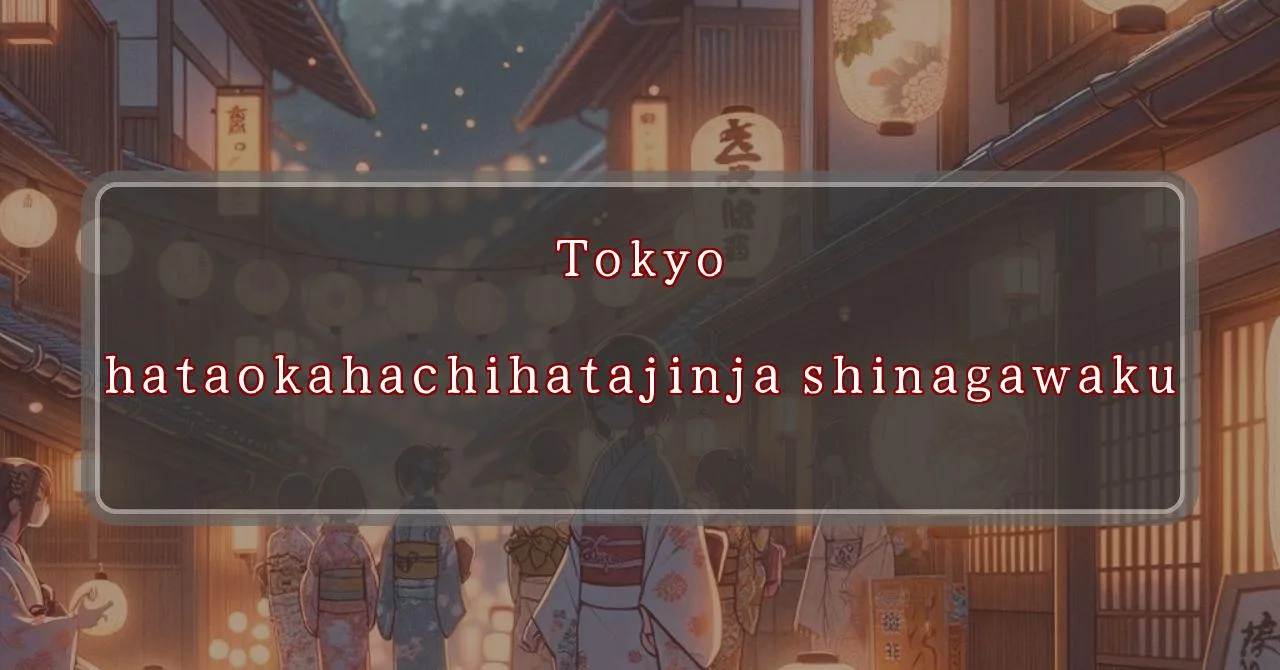Gleaming shrine, vibrant festival, rich history.
Shinto shrine located in Shinagawa, Tokyo, Japan.
- Address: 3-6-12 Hatagaya, Shinagawa-ku, Tokyo 142-0064
- Phone Number: 03-3781-5800
- Access: 2-minute walk from Ebaramachi Station on the Tokyu Oimachi Line, 8-minute walk from Hatagaya Station on the Tokyu Ikegami Line
- Festival Days: Second Saturday and Sunday of September (subject to change depending on the year)
Hachiman Shrine’s annual festival is a lively and colorful event that attracts many visitors each year. The main events and attractions of the festival include:
Mikoshi Procession
One of the highlights of the festival is the mikoshi procession, where a portable shrine is carried through the streets of the neighborhood. The mikoshi is decorated with colorful tapestries and streamers, and it is carried by a team of people. The procession is accompanied by music and dancing, and it creates a festive atmosphere.
Kagura Performance
Kagura is a traditional Japanese dance and music performance that is often performed at Shinto shrines. During the Hatagaya Hachiman Shrine festival, kagura performances are held in the shrine’s kagura殿 (hall). The performances are typically very lively and entertaining, and they give visitors a chance to learn more about Japanese culture.
Food Stalls
No Japanese festival is complete without food stalls! At the Hatagaya Hachiman Shrine festival, there are many food stalls selling a variety of delicious treats. Some of the most popular items include yakitori (grilled chicken skewers), takoyaki (octopus balls), and kakigori (shaved ice with syrup). There are also many stalls selling souvenirs and crafts.
Bon Odori
Bon Odori is a traditional Japanese dance that is performed during the Obon festival, which is a time to remember and honor the dead. During the Hatagaya Hachiman Shrine festival, there is a Bon Odori performance on the evening of the second day of the festival. Visitors are encouraged to join in the dance, which is a great way to experience Japanese culture and have some fun.
Blessings and Deities
Hatagaya Hachiman Shrine is dedicated to the following deities:
- Hachiman-shin: The god of war and archery, and the patron deity of the Minamoto clan.
- Hime-no-kami: The goddess of fertility and childbirth.
- Okinaga-tarashi-hime-no-mikoto: The goddess of longevity and good health.
Visitors to the shrine can pray for success in battle, victory over enemies, a safe childbirth, good health, and a long life.
Origin and History
The origins of Hatagaya Hachiman Shrine are unclear, but it is believed to have been founded in the 11th century by Minamoto Yorinobu, the founder of the Minamoto clan. The shrine was originally located in a different part of Shinagawa, but it was moved to its current location in 1603.
Hatagaya Hachiman Shrine has a long and rich history. It has been visited by many famous people over the years, including the shogun Tokugawa Ieyasu and the emperor Meiji. The shrine has also been the site of many important events, such as the signing of the Treaty of Kanagawa in 1854.
Tips and Notes for Visitors
Here are some tips and notes for visitors to Hatagaya Hachiman Shrine:
- The shrine is open every day from 9:00 AM to 5:00 PM.
- Admission is free.
- There is a large parking lot available for visitors.
- The shrine is a popular tourist destination, so it can be crowded during peak times.
- If you are visiting the shrine during a festival, be sure to check the schedule of events in advance.
Parking Information
There is a large parking lot available for visitors to Hatagaya Hachiman Shrine. The parking lot is located next to the shrine, and it can accommodate up to 100 cars.
The parking fee is 500 yen per day.
Popular Stalls and Food Carts in Recent Years
| Type of Stall | Description |
|---|---|
| Takoyaki | A staple at Japanese festivals. Characterized by a crispy outside and a creamy inside. |
| Jaga Butter | A simple yet popular snack of hot potatoes lavishly topped with melted butter. |
| Baby Castella | Small castella cakes, sweet and fluffy treats enjoyed by children and adults alike. |
| Grilled Ayu with Salt | Fresh ayu fish grilled whole with salt, a savory taste of Japanese summer. |
| Shaapin | A unique gourmet item influenced by foreign cuisine, with a chewy skin wrapping the filling. |
| Okonomiyaki | A Japanese grilled dish where you often choose your own ingredients for a personalized flavor. |
| Cotton Candy | A fluffy, sweet snack that’s extremely popular with children. |
| Chocolate Banana | A banana coated in chocolate, a fun and visually appealing dessert. |
| Kushiyaki | Various types of ingredients skewered and grilled, an easy-to-enjoy snack. |
| Yakisoba | Fried noodles mixed with a special sauce, a fast food favorite in Japan. |



